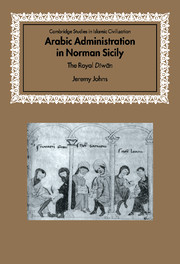Book contents
- Frontmatter
- Contents
- Preface
- Tables
- Abbreviations
- Genealogical table of the De Hautevilles of Sicily
- Note on Measurements
- Introduction
- 1 ‘In the time of the Saracens …’
- 2 ‘When first the Normans crossed into Sicily …’
- 3 ‘Our lady, the Regent Adelaide, and our Lord, the Count Roger, her son’, 1101–30
- 4 The earliest products of the royal dīwān, 1130–43
- 5 The jarāʾid renewed, 1144–5
- 6 The records of the royal dīwān. Part I: the jarāʾid al-rijāl
- 7 The records of the royal dīwān. Part II: the dafātir al-ḥudūd
- 8 The duties and organisation of the royal dīwān, 1141–94
- 9 ‘The people of his state’. The ‘palace Saracens’ and the royal dīwān
- 10 The Norman dīwān and Fāṭimid Egypt
- 11 Royal dīwān and royal image
- Appendix 1 Catalogue of dīwānī documents
- Appendix 2 Provisional catalogue of private documents
- Appendix 3 Abū Tillīs – ‘Old Wheat-sack’
- List of References
- Index
- Titles in the series
9 - ‘The people of his state’. The ‘palace Saracens’ and the royal dīwān
Published online by Cambridge University Press: 10 March 2010
- Frontmatter
- Contents
- Preface
- Tables
- Abbreviations
- Genealogical table of the De Hautevilles of Sicily
- Note on Measurements
- Introduction
- 1 ‘In the time of the Saracens …’
- 2 ‘When first the Normans crossed into Sicily …’
- 3 ‘Our lady, the Regent Adelaide, and our Lord, the Count Roger, her son’, 1101–30
- 4 The earliest products of the royal dīwān, 1130–43
- 5 The jarāʾid renewed, 1144–5
- 6 The records of the royal dīwān. Part I: the jarāʾid al-rijāl
- 7 The records of the royal dīwān. Part II: the dafātir al-ḥudūd
- 8 The duties and organisation of the royal dīwān, 1141–94
- 9 ‘The people of his state’. The ‘palace Saracens’ and the royal dīwān
- 10 The Norman dīwān and Fāṭimid Egypt
- 11 Royal dīwān and royal image
- Appendix 1 Catalogue of dīwānī documents
- Appendix 2 Provisional catalogue of private documents
- Appendix 3 Abū Tillīs – ‘Old Wheat-sack’
- List of References
- Index
- Titles in the series
Summary
After the brief appearance of Abū l-Ḍawv in the 1120s, both the documentary and the literary sources fall more or less silent about the Arab staff of the royal dīwān until the 1140s. From then until the end of the kingdom, although almost no trace has survived of the internal records of the dīwān, and although its organisation and precise duties remain tantalisingly obscure, we are surprisingly well-informed about its Arab directors. This embarras de richesse should put us on our guard, and encourage us to ask why both Latin observers, such as ‘Hugo Falcandus’ and the interpolator of Romuald of Salerno, and Arab visitors to Sicily, such as Ibn Qalāqis and Ibn Jubayr, were so interested in, and so well-informed about, the Arab servants of the Norman kings. Such general questions must remain unanswered, until they are finally addressed in the conclusion of this chapter. It opens with the account of the palace servants in 1184–5 given by Ibn Jubayr, and then returns to the reign of King Roger for the first of six prosopographical sections on the Arab servants of the palace and the dīwān.
Ibn Jubayr and the eunuchs
During his enforced stay in Sicily, in the winter of 1184–5, the Spanish pilgrim Ibn Jubayr met leading Arab servants of King William II on several occasions in Messina and Palermo, and enjoyed the hospitality of Abū l-Qamacr;sim ibn Ḥammūd in Palermo and Trapani. His account of the Arab servants provides a colourful and surprisingly detailed background to this chapter, and I shall return repeatedly to it.
- Type
- Chapter
- Information
- Arabic Administration in Norman SicilyThe Royal Diwan, pp. 212 - 256Publisher: Cambridge University PressPrint publication year: 2002



